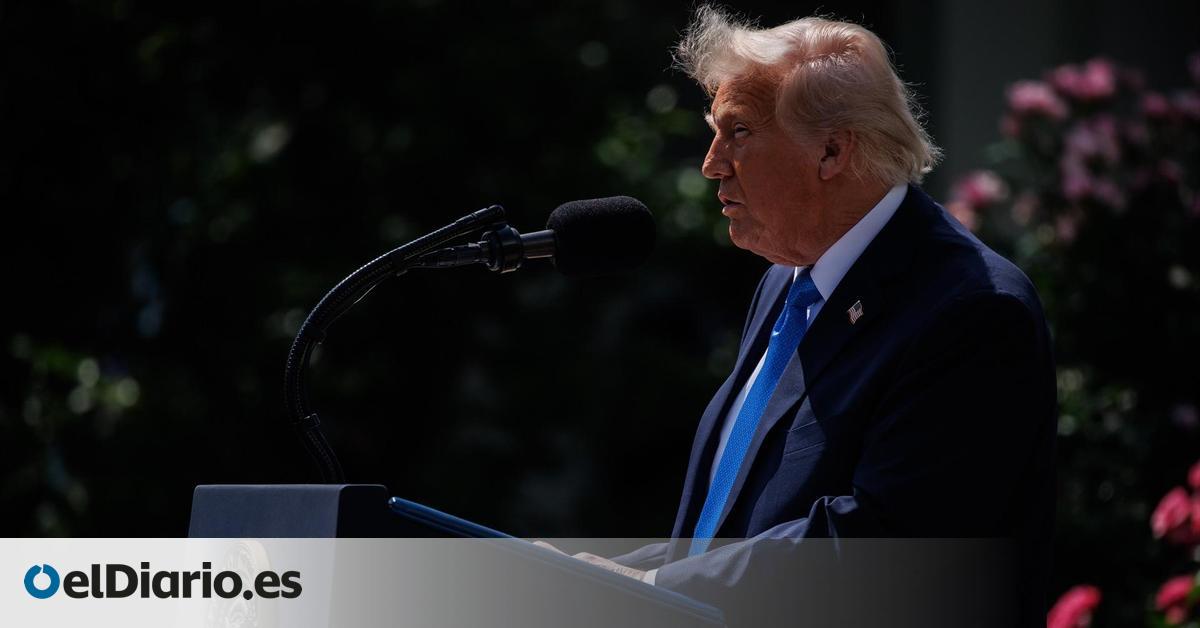
“The probability of a recession in the next four quarters in the Eurozone and the United States has increased considerably.” The statement was collected in the minutes of the last meeting of the Governing Council of the European Central Bank (ECB), which was held in mid -April. Then, the worst commercial scenario for the European Union (EU) that was on the table were 20% tariffs on exports of goods in general to the United States and 25% for steel and aluminum. This Friday, the administration of Donald Trump increased the threat to 50% and burst all projection exercises until that moment, firing the uncertainty and the risk that the economy is paralyzed to one side and the other of the Atlantic.
“The tariff types are so stratospheric that they no longer mean much. One might ask why Trump opts for a 50% tariff against the EU instead of 25% or 100%. Perhaps they increase their 100% tariff threats in a few hours or turn back at the end of the day. No one knows it, probably not even himself,” he laments Agathe Demarais, a researcher of the European Council of Foreign Affairs. Analysis formed by dozens of EU politicians.
The main national and international institutions (IMF, OECD or the Bank of Spain in our country) have already been advancing this same conclusion: the problem is not only the direct impact of the “commercial channel” and the tariffs that end up suffering exports from the EU to the United States, but the blows that the real economy is receiving come through other channels. “Mainly the financial and that of uncertainty,” according to Ángel Gavilán, General Director of Economics of the Bank of Spain, in the presentation of the annual report of the institution, after which he resigned a day later, as explained in this information.
That “financial channel” showed this Friday that Trump’s new announcement was unexpected, “continues Agathe Demarais. The aggressiveness and fluctuations of trade negotiations are able to erase billions of the bags during hours, generating a scenario of absolute volatility beyond the financial universe. Some ‘moving lands’ in which the result can end up being that companies are thought twice their real investments and the continuity of their projects, and even that families also change their plans and their spending decisions. In short, the more tension, the more risk of certain activities.
The governor of the Bank of Spain, José Luis Escrivá, summarizes it in his presentation of the annual report of the institution: “The simulations [hasta este semana] They suggest that an increase in tariffs would negatively affect the level of world activity, particularly in the United States and more contained in the Economic and Monetary Union (EMEM) and, especially, in Spain. However, if these commercial tensions increase due to a deterioration of global financial conditions or levels of uncertainty, the negative impact on GDP [Producto Interior Bruto] would increase ”.
In the current context, any attempt to make forecasts with specific numbers is an impossible exercise subject to multiple scenarios. Spain starts as the economy less directly exposed to the United States among the great EU countries. In addition, in the face of the weakness of the Eurozone team, and specifically from Germany, our country leads growth projections [con estimaciones cercanas al 2,5% de avance del PIB] Thanks to certain positive dynamics – tourism, exports of other services, energy transition or arrival of immigrants – from the pandemic and that have remained to the first quarter of this 2025, and some incipient structural changes in the labor market – more employment and less precariousness – and in the productive structure – activities of more added value.
In recent years, Spain has registered an increasing surplus with the United States in services [le vendemos más de lo que le compramos]”Which has been counteracted by a deficit in the trade of goods that, since 2022, has increased significantly as a result of the increase in energy imports,” observes the Bank of Spain. “The volume of Spanish foreign trade with the United States – as the import ratio more exports on GDP – is slightly higher than 4% of GDP. A figure that is greater than 7% in Germany and greater than 5% in Italy; countries that also have an important commercial surplus with the US economy, particularly in the trade of goods,” he adds.
But the main partners and their industrial sectors to which Spain is exposed make the indirect impact of a commercial war such as that raised by the United States is inevitable. The Bank of Spain has done an exercise in which it adds direct damage and the one that would arrive through other countries, such as Germany, France or Italy. “This indirect channel raises the exposure of the Spanish economy to the United States in a particularly relevant way for some industrial sectors. Especially the Spanish industries whose added value is more exposed to the demand of the United States are those linked to the pharmaceutical and chemical sectors, oil and metals,” summarizes the institution.
In this third graphic, only those branches whose direct and indirect exposure exceeds 8%is shown. Direct exposure shows the percentage of direct exports to the United States on the total production of each sector. The sum of the direct and indirect exposure shows the percentage of the gross added value of each sector involved in the direct exports of the sector itself, as well as in the supply of intermediate inputs to other exporters to the United States.
According to the Bank of Spain, for our country and for the EU, “the amplification channels (financial and trust) are quantitatively more relevant than the commercial.” For example, “as a consequence of the commercial war, there has been a remarkable appreciation of the euro against the dollar. This could mean a certain loss of competitiveness for the Spanish tourism sector, which would negatively affect the arrivals of foreign tourists to our country and/or its level of spending during their stay, although with a certain delay (approximately a year and a half),” he explains.
In addition, the rise of the ‘common currency’ with respect to the dollar has a double effect. On the one hand, it lowers imports of oil or gas, which are traded in dollars, and supports the moderation of inflation. On the other, exports make exports from the eurozone, adding to the increase in costs for the importers of the United States that involve Donald Trump’s tariffs. That is, aggravating the coup to economic activity
“It is not surprising that Trump is looking in Europe now that the United States and China have agreed to a commercial truce. Trump’s demands seem to reflect their deep frustration with the professional, quiet and bureaucratic approach of the EU in commercial negotiations, which contrasts with its willingness to quickly sign agreements with an attractive image, even if they mean very little,” says the investigator of the European Council of the European Council of Foreign Affairs.
“There is no clarity regarding the commercial objectives of the United States, which makes negotiations almost impossible for Europe. Negotiators ask what US demands really are. These could include requests that the EU reduces its economic ties with China; commitments to buy more LL [gas natural licuado] or American weapons; or an agreement to reform VAT regimes in all member states, ”he concludes.
“In any case, the final impact of an increase in tariffs on the volume of exports will depend on multiple factors, such as the possibility of other countries to implement ‘reciprocal tariffs’; These find alternative export markets to the United States or can rebuild their product offer, ”analyzes Governor José Luis Escrivá.
Source: www.eldiario.es

